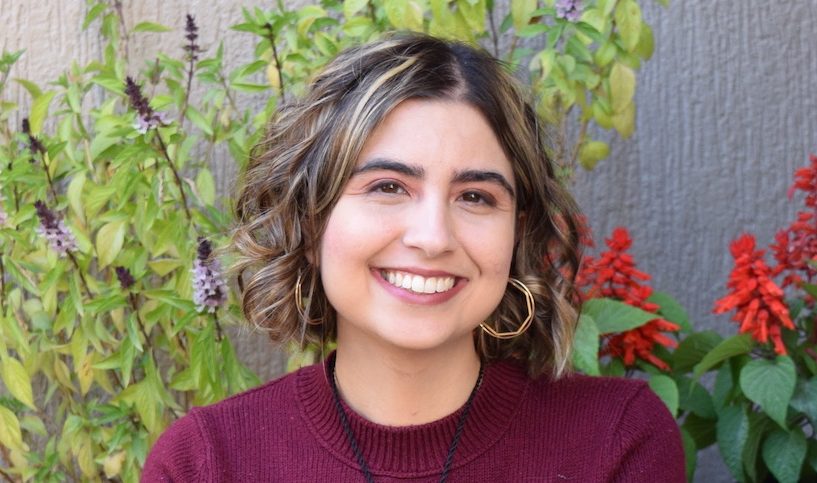For as long as I can remember, I read books to escape, and my favorite genres have always been Sci-Fi and Fantasy. I am often looking for elaborate world building, surprising plots, and layered character development. And until recently, these worlds were written by white men. While many of the stories that I read were fantastic, they were often lacking in authentic representation, diversity and a non-western perspective.
In the last couple of years, I enjoyed The Wrath and the Dawn by Renee Ahdieh, We Hunt the Flame by Hafsah Faizal and City of Brass by S.A Chakraborty. I came across a new book called The Stardust Thief, on Instagram that had just been released, instantly purchased the e-book version, and fell in love. I later realized that the author, Chelsea Abdullah is an American-Kuwaiti and this was her debut novel. I had so many questions, and she delivered with the answers.
How do you introduce yourself?
I’m an American-Kuwaiti writer who loves exploring found family dynamics and experimenting with storytelling structures. In my free time I read, play video games, and sometimes draw!
Did you always think you were going to be an author? How long has this book been brewing in your head?
I’ve always loved writing and had dreams of being published, but it was only during my undergrad career that I started seriously thinking about traditional publication.
The concept for The Stardust Thief has been floating around in my head for more than six years at this point. When I left Kuwait to go to university in the states, I started thinking on the idea of writing an Arab-inspired fantasy that was a love letter to the stories I grew up with. I sat on that idea for years before the opening scene of this novel came to me. As I started writing, I realized this was the fantasy I’d been building myself up to write. It was my fifth completed manuscript and the first one I felt confident enough to edit and send to agents. I’m very happy it’s my debut novel!
How would you briefly describe The Stardust Thief?
The Stardust Thief is an epic fantasy that follows a merchant, a prince, a bodyguard, and a thief on their journey to find a mythical lamp. On the way they’ll have to face a myriad of dangers, including a dangerous jinn queen, a malicious killer from the past, and an unfortunate number of ghouls…
There’s a map in the beginning of the book, did you begin writing with this in mind, or was it a product of the writing? How much of Kuwait and the landscape (the dust storms and the journey across the desert) inspired the writing?
The story came first! The map is a very recent creation, designed by a cartographer after I wrote the book and signed with a publisher. It was an incredible experience to work with him to design the map based on the journey the characters take in the book.
Since I grew up in Kuwait, a lot of my inspiration for the landscape comes from its geography and climate. There’s one scene in the novel where the characters have to travel through a vicious dust storm, and it’s based on my memories of a really bad sandstorm that happened in Kuwait in 2011. I remember the sky turned orange and then black, and that I couldn’t see anything beyond the windows of my house. I also remember the videos that were circulating on Youtube at the time that showed how thick the layers of sand were. That storm immediately came to mind when I wrote the dust storm scene in The Stardust Thief.
World building is always tricky, but this world feels real and well thought out, what was your process like for creating this world?
I’m a discovery writer, so the world unfolds for me as I write the first draft. I like to say it’s like I’m following a sparse map at that stage—I know what some locations are going to look like and where they are, but the characters are the ones who show me how to get from Point A to Point B. Because they all notice different things about the world, I discover unique pieces of the lore every time I swap perspectives.
That being said, though The Stardust Thief is a high fantasy that takes place in another, fantastical world, there are elements in it that are inspired by my Arab heritage. The food, the clothing, the architecture, the social dynamics… And, of course, all the Arabic phrases and names!
What’s your process of writing in general like? Can you describe what a day of writing looks like for you?
I’m a pantser and an overwriter, which means that I discover the story during my first draft, which tends to be very long because I spend so much of it exploring the world. The Stardust Thief is a pretty big book, but I chopped the wordcount in half from what it was originally. I like to play and explore the world and the characters in the first draft and then, once I’ve figured out how the story ends, I go back and tear out the unnecessary tangents and polish the character arcs.
My daily writing schedules varies. Because I work a full-time job, I usually write in the evening after dinner. I have my draft open, as well as all my notes on Scrivener and in my notebooks. When I’m stuck, I like to try writing my notes by hand; sometimes it helps me gain enough distance from the story to see things more clearly. Most of the time though, I’m editing directly in my document.
One of my favorite things about the book is that it’s not based in euro-centric mythology or fantasy, was this something you had in mind while writing the book? Did you want to introduce more readers to the world of Arabic fantasy?
Yes, that’s how The Stardust Thief started for me! As a kid, I always wished to see more Arab-coded characters in popular fantasy books. There were so many popular Eurocentric fantasies, but it wasn’t until I was an adult that I saw other fantasies on the market that featured well-written Arab representation in fantasy. Still, those novels were few and far between, and I’ve always wanted to see more of them.
The Stardust Thief started as a personal project. I wrote it because I missed home. It was only when I finished it that I realized maybe other people might like to read it if I edited it into something more book-shaped. I’m always happy when readers tell me a) they have a new appreciation for Arab storytelling traditions after reading or b) they saw echoes of their own heritage in the story.
What was the hardest thing about writing the book? Is there anything that you learned about yourself while writing it that surprised you?
The hardest thing for me was definitely all of the cutting I had to do. My first draft was originally 297,000 words. The final draft is around 144,000. Since the finished book is 480 pages…you can only imagine how long that first draft manuscript was! The Stardust Thief was the first book I edited with the thought of pursuing traditional publication. I spent more than two years preparing this draft to send out to agents.
In general, I learned a lot about my process while writing this book. One of the things this story made me come to terms with is the fact that I’m a multiple-perspective writer. Every time I try to write through a single character’s eyes—as I originally attempted with The Stardust Thief—I become restless and end up having to step into another characters’ shoes. At this point, I’ve accepted that’s just the kind of writer I am!
What drove the story while you were writing, the characters or the plot?
Definitely the characters. Every novel I write begins with an out-of-context scene featuring new characters. Usually, I don’t know who the characters in the scene are, but that’s the reason I write the novel: to figure out who the protagonists are and what their story is.
I noticed three strong themes found family, accepting vulnerability and facing fears in the book. Were those things you were intentionally exploring?
I think those are all themes that naturally wove their way into the story. I did, however, go into the narrative knowing at least one of the main relationships would center the found family trope. But the bits about vulnerability and facing your fears—those were reactions that came from the characters naturally as I was writing.
After finishing this book, however, I realized those moments of vulnerability are actually very important to me as a writer. Fantasy is filled with tough, jaded heroes. I wanted to write protagonists that were messy and relatable, people who are simply trying their best under difficult circumstances. Having to face your own fears and come to terms with your own vulnerability is a part of what it means to be human, I think, so I’ve realized I always write those moments into my story.
What inspired the main characters (Loulie, Qadir, Mazen, Aisha and Omar)?
Loulie and Qadir were inspired by a visual image, the first out-of-context scene that came to my mind when I started conceptualizing the story. The image was this: A merchant in star-dusted robes sat on a ship, a coin dancing between her knuckles, as her bodyguard loomed behind her. I didn’t know anything about Loulie and Qadir at first. I decided to write the story to figure out who they were.
I thought up Mazen shortly after Loulie and Qadir. I knew he and Loulie would interact but I didn’t mean for him to have his own perspective until I started writing the draft and realized I loved his voice. Once I’d written a chapter through his eyes, I realized the story didn’t feel complete without him, so I made him a main protagonist.
Aisha’s inception is very different; she appeared on the page as a nameless side character at first but then, because I was so interested in her, she quickly became a main character. It’s hard for me to believe she was ever a minor character at this point.
Omar was the most secretive character. He, like Aisha, only revealed his demeanor to me as I was writing him on the page. Though I knew of his existence before I jumped into the first draft, I didn’t know much about him until he started to interact with his brother, Mazen.
All of them have their prejudices in the beginning, but throughout the journey they seem to learn more about themselves and are changed at the end. Was this a conscious choice?
It all happened naturally as I was writing! I had a very basic idea of the emotional journeys I wanted the characters to take, but I didn’t know what the details of that journey would be until they lived them out on the page. The early drafts revealed the emotional plot beats to me, and I smoothed them all out during edits.
All the characters have gone through traumatic experiences. The grudges they hold are unique to their circumstances, and their worldviews are heavily influenced by their histories. As the story goes on, some of these characters become mirrors and foils for each other. That was one of the most incredible things about writing their dynamics—they all naturally opened up to each other and forced one another to question each other’s beliefs.
We have a rich history of oral tradition in our region, did you research any of the different tales while writing your book?
Most of the stories are based on folktales my dad told me growing up, including stories from Failaka, but I definitely did additional research to make sure I remembered all the details correctly. The easiest tales to research were the 1001 Nights stories, if only because there are so many translations and resources, but I was mostly inspired by the versions my dad used to share.
Who’s your favorite character in the book?
This is such a hard question for me because I really do love writing all of them for different reasons.
Mazen is the easiest for me to write. I love his unabashed affection for stories and appreciate that he wears his emotions so openly—it makes it easier for me to know what’s going on in his head!
Loulie is the most difficult to write because she’s a storm cloud of emotion. Many of her feelings are murky, even to herself. But that’s what makes her so much fun to write. I love peeling back her layers draft by draft. She’s a complex, emotional character, and I love finding out more about her.
Aisha, I love for her decisiveness. She’s the type of character that will claw her way out of a plot hole on her own. She knows what she wants, what her strengths are, and she’ll stop at nothing to reach her goals.
When can we expect the sequel? And is it going to be a trilogy?
There’s no date set for the sequel yet since I’m still working on it, but I’m hopeful I’ll be able to share more about it within the next few months. I can confirm that this is going to be a trilogy, which is really exciting. I’m so happy to have three books in this world and with these characters!
Follow Chelsea on Instagram @chelsabdullah and visit her website chelseaabdullah.com to stay up-to-date with her latest news.











